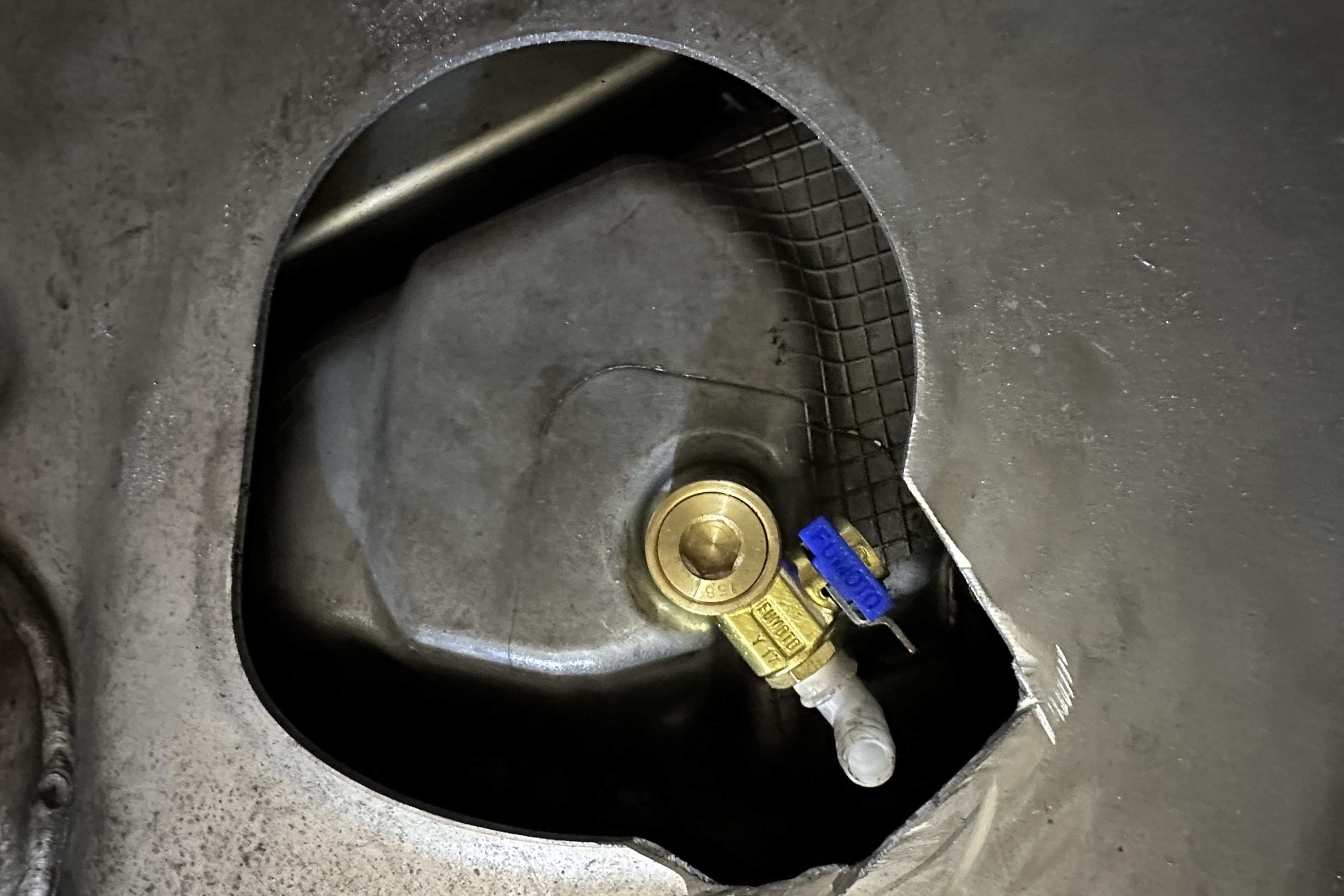Home>Automotive>The Surprising Symptoms Of Low Transmission Fluid And The Shocking Consequences Of Driving Without It


Automotive
The Surprising Symptoms Of Low Transmission Fluid And The Shocking Consequences Of Driving Without It
Published: January 18, 2024
Discover the unexpected signs of low transmission fluid and the potential dangers of driving without it. Learn how to prevent costly repairs with our automotive tips.
(Many of the links in this article redirect to a specific reviewed product. Your purchase of these products through affiliate links helps to generate commission for Noodls.com, at no extra cost. Learn more)
Table of Contents
Introduction
Your vehicle's transmission is a critical component that ensures the smooth operation and efficiency of your car. It is responsible for transferring power from the engine to the wheels, allowing your vehicle to accelerate, decelerate, and shift gears seamlessly. However, for this complex system to function optimally, it requires a vital fluid known as transmission fluid.
Transmission fluid serves as a lubricant, coolant, and hydraulic fluid within the transmission system, enabling it to operate smoothly and efficiently. Without an adequate level of transmission fluid, your vehicle's transmission can experience a myriad of issues, potentially leading to costly repairs and compromised safety on the road.
In this article, we will delve into the world of transmission fluid, exploring its significance, the surprising symptoms that indicate low levels, and the shocking consequences of driving without it. Additionally, we will provide essential insights on how to check and maintain proper transmission fluid levels, empowering you to safeguard your vehicle's transmission and ensure a smooth driving experience.
Join us on this journey as we unravel the crucial role of transmission fluid and equip you with the knowledge needed to address potential transmission issues proactively. Let's embark on this enlightening exploration of transmission fluid and its impact on your vehicle's performance and longevity.
What is Transmission Fluid?
Transmission fluid is a specialized lubricant that plays a pivotal role in the optimal functioning of a vehicle's transmission system. It is a versatile fluid that serves multiple essential purposes to ensure the smooth operation and longevity of the transmission.
Lubrication:
One of the primary functions of transmission fluid is to lubricate the various moving parts within the transmission system. As the gears, bearings, and other internal components operate, they generate friction and heat. Transmission fluid acts as a lubricant, reducing friction and preventing excessive wear and tear on these crucial components. This lubrication is vital for maintaining the efficiency and durability of the transmission system.
Cooling:
In addition to lubrication, transmission fluid also functions as a coolant for the transmission system. As the transmission operates, it generates heat due to the friction and mechanical processes occurring within it. The transmission fluid absorbs this heat, helping to dissipate it and maintain a stable operating temperature within the transmission. By regulating the temperature, transmission fluid prevents overheating and thermal breakdown of the transmission components, thereby preserving their integrity and performance.
Hydraulic Operation:
Transmission fluid serves as a hydraulic fluid, enabling the transmission system to engage gears, shift smoothly, and transfer power from the engine to the wheels. The hydraulic properties of the fluid allow for precise and efficient operation of the transmission's internal mechanisms, facilitating seamless gear changes and overall performance.
Contaminant Removal:
Furthermore, transmission fluid helps to keep the transmission clean by trapping and suspending contaminants such as metal particles and debris that may enter the system over time. This prevents these impurities from accumulating and causing damage to the transmission components, ensuring the system remains free from harmful debris.
In essence, transmission fluid is a multi-functional fluid that provides crucial lubrication, cooling, hydraulic operation, and contamination control within the transmission system. Its diverse properties are essential for preserving the integrity and functionality of the transmission, making it a vital component of any vehicle's drivetrain.
The Importance of Transmission Fluid
Transmission fluid is an unsung hero in the realm of automotive maintenance, silently playing a pivotal role in the seamless operation and longevity of a vehicle's transmission system. Its significance cannot be overstated, as it serves as a lifeline for the intricate network of gears, clutches, and other internal components within the transmission.
Lubrication stands as one of the primary functions of transmission fluid. As the gears and bearings within the transmission system move and interact, they generate friction and heat. Without proper lubrication, these components would succumb to premature wear and tear, leading to diminished performance and potential mechanical failures. Transmission fluid steps in as a protective barrier, reducing friction and ensuring that critical parts operate smoothly, thereby extending the lifespan of the transmission.
Moreover, transmission fluid acts as a coolant, effectively managing the temperature within the transmission system. As the transmission operates, it generates heat due to the mechanical processes occurring within it. The transmission fluid absorbs this heat, preventing overheating and thermal breakdown of the transmission components. By maintaining a stable operating temperature, transmission fluid safeguards the integrity of the transmission, ensuring that it operates optimally even under demanding conditions.
The hydraulic properties of transmission fluid are equally essential. They facilitate the precise and efficient operation of the transmission system, enabling smooth gear changes and the transfer of power from the engine to the wheels. Without the hydraulic capabilities of transmission fluid, the transmission system would struggle to engage gears and shift smoothly, leading to a compromised driving experience and potential damage to the transmission components.
Furthermore, transmission fluid serves as a custodian of cleanliness within the transmission system. It captures and suspends contaminants such as metal particles and debris, preventing them from accumulating and causing harm to the internal components. By keeping the transmission free from harmful impurities, transmission fluid plays a crucial role in preserving the integrity and longevity of the transmission system.
In essence, transmission fluid is a multifaceted guardian of the transmission, providing essential lubrication, cooling, hydraulic operation, and contamination control. Its diverse functions are instrumental in ensuring the smooth and reliable performance of the transmission system, making it a cornerstone of vehicle maintenance and longevity.
Surprising Symptoms of Low Transmission Fluid
Recognizing the signs of low transmission fluid is crucial for maintaining the health and functionality of your vehicle's transmission system. While some symptoms may be subtle, they can serve as early warnings of potential transmission issues. By being attuned to these surprising symptoms, you can address low transmission fluid proactively, preventing further damage and costly repairs down the road.
-
Gear Slippage: One of the most common indicators of low transmission fluid is gear slippage. If you notice that your vehicle is experiencing difficulty staying in gear or is shifting erratically, it could be a sign of inadequate transmission fluid. Insufficient fluid levels can lead to decreased hydraulic pressure within the transmission, causing gears to slip or struggle to engage properly.
-
Delayed Shifting: Low transmission fluid may manifest as delayed or hesitant shifting between gears. When the fluid level is inadequate, the transmission system may struggle to transition smoothly from one gear to another. This can result in a noticeable delay when accelerating or decelerating, indicating a potential issue with the transmission fluid level.
-
Unusual Noises: A telltale sign of low transmission fluid is the emergence of unusual noises during vehicle operation. You may hear whining, clunking, or buzzing sounds emanating from the transmission as a result of insufficient lubrication. These noises often indicate excessive friction and strain on the transmission components, highlighting the need to address the fluid level promptly.
-
Transmission Overheating: Inadequate transmission fluid can lead to increased operating temperatures within the transmission system. If you observe the transmission temperature gauge climbing higher than normal or receive overheating warnings, it could be a sign of low fluid levels. Elevated temperatures can accelerate wear and tear on transmission components, necessitating immediate attention.
-
Fluid Leaks: While not a direct symptom of low transmission fluid, visible fluid leaks beneath the vehicle can indicate a potential loss of transmission fluid. If you notice red or brown fluid pooling beneath your car, it may signify a transmission fluid leak, leading to diminished fluid levels. Addressing leaks promptly is essential to prevent further fluid loss and transmission damage.
Recognizing these surprising symptoms of low transmission fluid empowers you to take proactive measures to safeguard your vehicle's transmission system. By addressing inadequate fluid levels promptly, you can mitigate the risk of extensive transmission damage and ensure the continued reliability of your vehicle. Regularly monitoring transmission fluid levels and addressing any signs of deficiency is key to preserving the integrity and performance of your vehicle's transmission system.
Shocking Consequences of Driving Without Transmission Fluid
Driving a vehicle with insufficient or depleted transmission fluid can lead to a cascade of shocking consequences, posing a significant risk to both the vehicle and its occupants. The absence of proper transmission fluid levels can result in detrimental effects on the transmission system, potentially leading to extensive damage and costly repairs. Understanding these shocking consequences underscores the critical importance of maintaining adequate transmission fluid levels and addressing any deficiencies promptly.
-
Severe Transmission Damage: Operating a vehicle without sufficient transmission fluid can subject the internal components of the transmission to extreme friction and heat. Without the protective barrier of lubricating fluid, the gears, bearings, and other vital parts can experience accelerated wear and tear, leading to severe damage. This can compromise the functionality of the transmission and necessitate extensive repairs or even complete replacement of the transmission system.
-
Transmission Overheating: In the absence of proper fluid levels, the transmission is susceptible to overheating, jeopardizing its operational integrity. Elevated temperatures within the transmission can cause thermal breakdown of the fluid, resulting in diminished lubrication and cooling capabilities. This, in turn, can lead to further overheating and potential catastrophic failure of the transmission components.
-
Increased Friction and Wear: Without adequate lubrication from transmission fluid, the internal components of the transmission are subjected to heightened friction and mechanical stress. This can lead to accelerated wear on gears, clutches, and bearings, compromising their functionality and longevity. The absence of proper lubrication exacerbates the risk of premature component failure, potentially leaving the vehicle inoperable.
-
Compromised Performance and Safety: Driving without sufficient transmission fluid can impact the overall performance and safety of the vehicle. Gear slippage, delayed shifting, and erratic transmission behavior can compromise the driver's ability to control the vehicle effectively. This poses a safety risk to the occupants and other road users, as the compromised transmission can lead to unpredictable driving dynamics and potential hazards on the road.
-
Costly Repairs and Downtime: The shocking consequences of driving without transmission fluid culminate in the potential for costly repairs and significant vehicle downtime. Addressing the damage resulting from inadequate fluid levels requires extensive transmission repairs or replacement, resulting in substantial financial implications and inconvenience for the vehicle owner.
In light of these shocking consequences, it is imperative to prioritize the regular inspection and maintenance of transmission fluid levels. By ensuring that the transmission system is adequately lubricated, cooled, and protected, vehicle owners can mitigate the risk of experiencing the detrimental effects of driving without transmission fluid. Proactive maintenance and prompt attention to transmission fluid levels are essential for preserving the integrity, functionality, and longevity of the transmission system, ultimately safeguarding the vehicle and its occupants from the shocking consequences of inadequate fluid levels.
How to Check and Maintain Transmission Fluid
Maintaining proper transmission fluid levels is essential for ensuring the longevity and optimal performance of your vehicle's transmission system. Regularly checking and maintaining transmission fluid is a straightforward yet critical aspect of vehicle maintenance that can prevent potential transmission issues and costly repairs. Here's a comprehensive guide on how to check and maintain transmission fluid, empowering you to proactively care for your vehicle's transmission system.
Checking Transmission Fluid Levels
-
Consult the Owner's Manual: Begin by referring to your vehicle's owner's manual to locate the transmission fluid dipstick and understand the recommended procedure for checking the fluid level. Different vehicle models may have varying methods for accessing and inspecting the transmission fluid.
-
Engine Warm-Up: With the engine running, allow the vehicle to reach operating temperature by driving for a short distance or idling for a few minutes. It is essential to check the transmission fluid at the correct operating temperature, as this affects the fluid level readings.
-
Locate the Dipstick: Once the engine is warm, park the vehicle on a level surface and locate the transmission fluid dipstick, which is typically distinguished by a bright handle and is often situated near the rear of the engine bay.
-
Check the Fluid Level: Carefully remove the dipstick, wipe it clean with a lint-free cloth, reinsert it fully, and then withdraw it again to examine the fluid level. The dipstick will have markings indicating the optimal fluid level range, allowing you to assess whether the fluid level is within the recommended parameters.
Maintaining Transmission Fluid
-
Regular Inspections: Incorporate the inspection of transmission fluid into your routine vehicle maintenance schedule. Periodically checking the fluid level and condition enables you to identify any potential issues early and take corrective action if necessary.
-
Fluid Replacement: Depending on your vehicle's manufacturer recommendations, consider scheduling regular transmission fluid changes or flushes. Over time, transmission fluid can degrade, leading to diminished performance and potential damage. Replacing the fluid at specified intervals helps maintain the integrity of the transmission system.
-
Addressing Leaks: Keep an eye out for any signs of transmission fluid leaks, such as puddles or stains beneath the vehicle. Addressing leaks promptly is essential for preventing fluid loss and maintaining proper fluid levels within the transmission system.
By following these guidelines for checking and maintaining transmission fluid, you can uphold the health and functionality of your vehicle's transmission system. Proactive monitoring and care for transmission fluid levels are fundamental in preserving the integrity and performance of the transmission, ultimately contributing to a reliable and smooth driving experience.
Conclusion
In conclusion, the significance of transmission fluid in maintaining the health and functionality of a vehicle's transmission system cannot be overstated. This often overlooked fluid serves as a multifaceted guardian, providing essential lubrication, cooling, hydraulic operation, and contamination control within the transmission. Its diverse functions are instrumental in ensuring the smooth and reliable performance of the transmission system, making it a cornerstone of vehicle maintenance and longevity.
By recognizing the surprising symptoms of low transmission fluid, such as gear slippage, delayed shifting, unusual noises, transmission overheating, and fluid leaks, vehicle owners can proactively address inadequate fluid levels, mitigating the risk of extensive transmission damage and ensuring the continued reliability of their vehicles. Understanding the shocking consequences of driving without transmission fluid underscores the critical importance of maintaining adequate fluid levels and addressing any deficiencies promptly. The detrimental effects of driving without proper transmission fluid levels, including severe transmission damage, overheating, increased friction and wear, compromised performance and safety, and costly repairs and downtime, highlight the imperative of prioritizing the regular inspection and maintenance of transmission fluid levels.
Furthermore, the guide on how to check and maintain transmission fluid equips vehicle owners with essential knowledge and practical steps to ensure the longevity and optimal performance of their vehicle's transmission system. Regularly checking and maintaining transmission fluid is a straightforward yet critical aspect of vehicle maintenance that can prevent potential transmission issues and costly repairs. By incorporating the inspection of transmission fluid into routine maintenance schedules, scheduling regular fluid changes or flushes, and promptly addressing leaks, vehicle owners can uphold the health and functionality of their vehicle's transmission system.
In essence, transmission fluid is a silent yet indispensable ally, safeguarding the intricate internal components of the transmission and ensuring the seamless operation of the vehicle. By understanding its significance, recognizing potential deficiencies, and proactively maintaining proper fluid levels, vehicle owners can preserve the integrity and longevity of their vehicle's transmission system, ultimately contributing to a reliable and smooth driving experience. Therefore, prioritizing the care and maintenance of transmission fluid is not only a prudent investment in the vehicle's longevity but also a commitment to safety and performance on the road.













